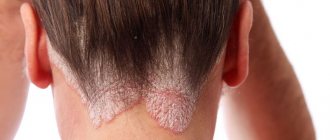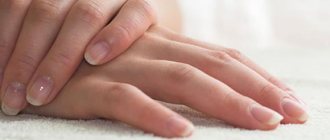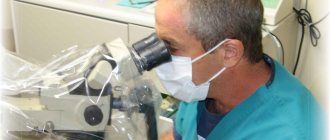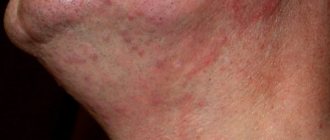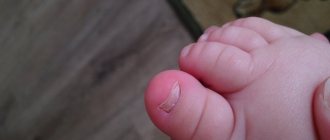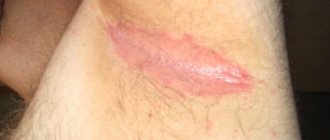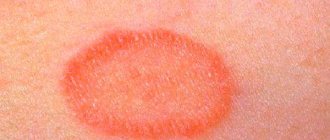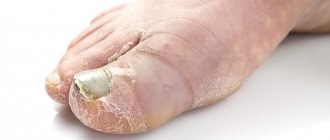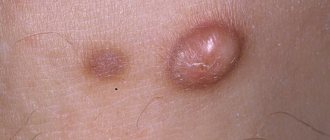Onychomycosis is a disease of the fingernails and toenails, caused by representatives of fungal microflora, gradually leading to the destruction of the nail plate with a change in its structure, color, and shape.
The causative agents of onychomycosis include three types of fungi:
- Dermatomycetes. Dermatomycetes are parasitic fungi, the main representatives of which are Trichophyton, Microsporum, Epidermophyton. In 80-85% of cases, it is dermatomycetes that become the source of nail fungus.
- Fungi of the genus Candida (yeast-like). The Candida fungus is present in the microflora of any human body, however, by its nature, it can begin to multiply sharply, causing nail fungus. Candida fungus infects the surface of the nail in 8-10% of cases.
- Mold. Molds are the rarest possible pathogens of nail fungus; they become infected only in 5-6% of cases.
Causes of nail fungus
In 100% of cases, onychomycosis occurs as a result of damage to the skin by mycotic pathogens. Contact of the skin of the foot with the infected surface leads to the penetration of the fungus through the upper layers of the epithelium into the nail, and consequently to further deformation of the nail plate. Depending on the location of the lesion, the following types of onychomycosis are possible:
A) The fungus enters the nail bed through the marginal surface of the nail. Since the infection is practically asymptomatic in the first days, it is difficult for the patient to notice any changes. But as the fungus grows in the nail bed itself, hyperkeratrosis begins to develop. Hyperkeratrosis is caused by a change in the color of the nail from light pink to yellowish; the connection between the surface of the nail and the nail bed is also weakened, which leads to separation and peeling.
B) The fungus can enter the nail through the free surface of the nail plate. This occurs when the spores have a high keratolytic ability (quickly destroy keratin). In this case, nail infection occurs much faster compared to the first option.
B) Through the nail fold (skin area adjacent to the nail plate). It occurs somewhat less frequently, however, with this method of infection, an inflammatory process of the nail matrix (root zone) can begin.
Causes of fungus
The causes of nail fungus can be different. In fact, it is very easy to get infected. It is enough to walk along the beach and step on the sand, in which cells from the carrier of the disease remain. It’s the same story with a public shower, just like with a swimming pool. Therefore, in such places, disinfection is often carried out, the task of which is to kill germs and viruses.
You can go to a shoe store and try on something that a person with toenail fungus has previously worn on their feet. At home, everything is also very simple - just as a sick relative can put on your shoes, or use your towel. There are quite a lot of options, but they all have one thing in common – contact. It can be both direct and indirect.
Read here: Treatment of herpes - types and symptoms of a viral disease, treatment methods and causes of the disease (100 photos and videos)
Such situations should be avoided, and methods of preventing nail fungus should not be neglected either. The general condition of the body also plays an important role. If your immune system is weakened, the likelihood of fungus entering your body increases.
Be careful about physical damage to the skin on your feet. You shouldn’t walk on the same beach if you have scratches or even wounds on your feet. Through damaged skin, the virus enters the body much more easily, but it is much more difficult for the immune system to cope with it.
Risk factors that can cause fungal nail infections
- flat feet or other structural features or development of the foot;
- varicose veins of the legs;
- reduced immunity due to previous diseases;
- HIV infection;
- increased sweating;
- wearing shoes and clothes made of synthetic materials;
- low aeration of the foot. This again occurs due to uncomfortable and tight shoes;
- mechanical damage to the foot;
- scratches, abrasions, open wounds;
- self-removal of ingrown toenails;
- frequent use of antibiotics;
- candidiasis (mainly in women);
- accompanying illnesses. Diabetes mellitus, thyroid dysfunction, dermatological diseases, diseases of the stomach, pancreas, and excess weight can also increase the risk of onychomycosis by up to 6-8 times;
Well, in addition to the listed factors, there are also ways through which you can directly become infected with nail fungus.
- Use of general personal hygiene items (pumice stone, washcloth, slippers, flip-flops)
- Visiting public saunas, baths, swimming pools, locker rooms without shoes.
- Wearing someone else's shoes
- Failure to comply with sterilization standards in beauty salons (especially pedicures).
Types of fungus
The infection can be caused by one of several types of fungus. It is important to understand that the first symptoms of fungus and treatment are closely related - a dermatologist can identify the problem by the first signs.
If dermatophytes cause nail fungus, you will immediately notice yellow spots on the nail plate, at first small. They can be either at the edges or in the middle. Later they will begin to appear, also yellow in color, but already stripes along the entire length of the nail.
When yeast fungus appears, active decomposition of the nail begins. Deformations appear quite quickly, as a result of which the nail can peel off from the flesh of the finger. This process is accompanied by inflammation and, in places, a burning sensation. The surrounding skin begins to dry out and peel off over time.
Symptoms, forms of onychomycosis
Symptoms of the disease depend on many factors: age, form of onychomycosis, degree of infection, and the condition of the body as a whole. Symptoms of nail fungus infection are accompanied by itching, burning, and skin irritation.
Read also Allergic dermatosis
Currently, dermatologists identify five main forms of nail fungus:
• Hypertrophic
Characterized by a sharp thickening of the nail plate. The thickness of the nail can exceed 3-4 mm - this occurs due to the increase in small skin scales growing on the infected surface of the nail. The lateral parts of the nail plate are subject to the greatest destruction; the middle (central) part, on the contrary, thickens. The edges of the nail begin to crumble heavily. Due to hypertrophic lesions, the nail becomes curved, narrow and very thick. In addition, there is a sharp change in the color of the nail, accompanied by peeling.
• normotrophic
It is the mildest form, since the nail, when infected with fungus, does not thicken, but remains the same. Only the color of the nail plate changes. The fungus begins with the appearance of a small yellow spot, which then quickly increases in size. If you do not consult a specialist and begin treatment, over time the spot will increase in size, gradually covering the entire area of the nail plate. Since a person can quickly detect a change in color, onychomycosis can be diagnosed early enough in the disease.
• Atrophic (Onycholytic)
The atrophic form of onychomycosis is accompanied by a sharp change in the color of the nail from pink to gray, followed by destruction of the nail structure. Characterized by rapid progression, over time leading to complete detachment of the nail plate from the nail bed. In other words, the patient can accidentally snag or pry the infected nail and completely “remove” it. The final stage of atrophic fungus is necrosis of the nail tissue.
• Lateralynaya and distalynaya
The lateral form is often diagnosed together with the distal type of fungus. The symbiosis of these varieties leads to a change in the color of the nail plate, starting with the appearance of longitudinal yellowish grooves with a subsequent increase in the area of the affected nail. Within 4-5 weeks, in the absence of proper treatment, the nail cells begin to die, and the nail itself begins to crumble severely. The final stage of lateral nail fungal infection is complete exposure of the nail bed, which is dangerous due to the risk of infection in areas of the mucous membrane.
• Total form of onychomycosis
Total nail fungus is the absence of treatment for any of the above types of onychomycosis. Please note that the nail very quickly changes color, flakes, crumbles and then is completely torn away from the nail bed. In this case, it is necessary to consult not only a dermatologist, but also a surgeon.
Diagnostics
Diagnostics prevents negative consequences. The distal form of onychomycosis is diagnosed more often than others. If onychomycosis is suspected, after an initial visual examination and a preliminary diagnosis, the doctor will prescribe additional examinations and tests. The type of fungus is determined and treatment is prescribed. Diagnostic methods include:
- general urine analysis;
- blood chemistry;
- electrocardiography;
- bacteriological culture of scrapings from the affected area;
- microscopic examination of biological material.
Stages of onychomycosis
To prevent yourself from becoming infected with toenail fungus, it is important to remember that infection, as well as subsequent nail deformation, never happens overnight. In medical terms, these are the primary lesion, the normotrophic stage and the hypertrophic stage of the disease.
At the initial stage, the nail is affected only at the edges; at the same time, the size of the affected area does not exceed 2-3 mm. In rare cases, the free edge of the nail may be affected. Before the damage to the nail itself, the skin of the feet becomes infected. The patient feels itching, chafing, calluses, and painful calluses may appear. Over time, the fungus moves from the foot to the nail. If you notice changes at this point and contact a specialist, there is a chance to completely preserve and restore the nail plate in a short time.
The normotrophic stage is the next stage of the disease. An intermediate process in which thickening of the nail plate has not yet begun, but the affected areas of the nail are already noticeable. The affected areas may be small (2-4 mm) or larger (more than 5 mm). Most often expressed in the form of thin vertical stripes with a yellowish tint. The first manifestation of toenail fungus is a change in color: it can be quickly noticed and treatment can begin in time.
The final stage of onychomycosis is the hypertrophic stage of the disease. It begins with the formation of a small spot under the nail, which then grows very quickly. It may be accompanied by an inflammatory process that occurs in parallel with the formation of purulent sacs. The nail plate thickens, crumbles, exfoliates, then sharply becomes thinner and finally, the death of the nail cells and its complete detachment occurs.
Read also Tuberculosis and actinomycosis of the genital organs
Important: the danger of hypertrophic nail damage also lies in the possibility of damage to nearby skin and transition to a chronic level. But such a development of events is only possible in the absence of timely medical intervention and subsequent treatment of nail fungus.
How the disease develops
More often, fungi enter the nail through the nail bed, where they penetrate through small cuts and cracks in the skin. With good health and strong immunity, the fungus does not develop.
Nail fungus progresses slowly. If left untreated, the infection spreads to other areas, eventually completely destroying the nail plate.
Onychomycosis often recurs. Up to 20% of people get sick again after successful treatment. Affected nails can become infected with bacterial flora and then acute paronychia occurs (inflammation of the tissues located around the nail plate).
Rice. 4. The photo shows fingernail fungus.
Treatment of nail fungus
The most widely used are various antifungal drugs. The mechanism of action of such drugs comes down not only to the destruction of the spores themselves, but also to the accumulation of the active substance in the nail plate itself. This allows you to avoid relapses and protect your legs from possible damage in the future.
Before choosing one or another drug, you must undergo a microbiological culture to identify the type of nail fungus, undergo a full diagnosis and consult with a dermatologist.
In the most modern dermatological clinics, the following methods are used to diagnose onychomycosis:
- KOH microscopy
- High-precision PCR diagnostics
Before prescribing a specific medicine, a dermatologist must take into account the nature of the fungal infection, the type of onychomycosis, the time that has passed since infection, and much more.
The most commonly used treatment methods: medication, laser and traditional medicine.
Medication
Among the medicinal antifungal drugs, the most widely used are varnishes, ointments and tablets.
At the initial stages of the fungus, it is recommended to use topical preparations, an important place among which is occupied by antifungal varnishes. Today, the varnishes Cyclopiroxolamine, Oflomil, Lotseril (5%), Batrafen (8%) are widely known.
Important: If the doctor has prescribed an antifungal varnish, the procedures should never be skipped, as otherwise the desired effect will not be achieved.
In addition to varnishes, there are also special ointments and gels that have the same antifungal effect. Ointments also belong to topical preparations. Most often, experts prescribe ointments: Terbinafine, Mycozoral, Mycoseptin, Nystatin, etc. The ointment should be applied to the affected areas of the nail and foot for a certain period. The exact time of treatment is prescribed by a specialist.
There are also antifungal tablets. Unlike ointments and varnishes, tablets are general-acting drugs that are taken orally. The following antifungal tablets are most often prescribed: Lamisil, Flucostat, Fluconazole, Diane-35, Diflucan, Orungal Nystatin, etc. Tablets are most often prescribed not at the initial stages of infection, but at a later date, when the fungus has already entered the normotrophic phase.
Laser treatment of fungus
Currently, some clinics offer hardware treatment of nail fungus using a laser. Penetrating into the subungual surface, the laser beam heats it up to the growth zone, thereby not only killing the fungus, but also stimulating the growth of a new nail. Research by scientists has shown that when the nail plate is systematically heated to a temperature of 60-70 degrees, fungal microorganisms die. Such a thermal effect without damaging surrounding tissues can only be achieved using laser radiation, since the laser beam has a length that reacts only to cells affected by mycoses. Despite the fact that the method of laser exposure to the lesion promises complete relief from nail fungus, dermatologists, as a rule, recommend undergoing several sessions of such treatment. Compared to drug therapy, this method is much more expensive, and therefore is not suitable for everyone.
And for those who are too lazy to see a doctor, there are still remedies from the arsenal of traditional medicine.
Experts advise turning to traditional methods exclusively in conjunction with ongoing systemic traditional treatment. Such remedies can be used as preventative measures to eliminate the likelihood of fungal recurrence in the future.
Read also Genital herpes - diagnosis and treatment
Here are a few recipes that are likely to be effective in treating nail fungus, but are not at all necessary. However, in the absence of other options for combating onychomycosis, it is not forbidden to use these simple recommendations.
1. The affected areas of the nail plate are treated with a 5% iodine solution twice a day. When applying iodine, a slight tingling and burning sensation may be felt. If the unpleasant sensations intensify, such treatment should be stopped and other methods of treatment should be turned to.
2. A 20% tincture is made from propolis, which is then applied to the fungus-affected areas of the skin and nails. The effect of propolis is that it promotes the rapid regeneration of damaged cells and restoration of the nail. The effect of propolis becomes noticeable after just a few uses.
3. One of the most famous ways to fight fungus yourself is to use kombucha. To prepare a compress, you need to cut off a small piece of ripe kombucha, use a bandage or gauze bandage to wrap the mushroom to the affected nail and leave overnight. In the morning, untie the bandage and remove dead nail particles. After this, it is necessary to treat the affected area and the skin around it with iodine solution or any other disinfectant. It is recommended to continue treating your nails with kombucha for 3-4 weeks.
Treatment methods
Therapy for onychomycosis depends on the degree of neglect and individual characteristics of the course of the disease. Treatment should be comprehensive and consist of both medications and auxiliary methods of traditional medicine.
You can learn about ways to treat foot fungus by following the link.
Pharmacy products
Incipient fungus responds well to external therapy.
Among the most popular and effective remedies are the following medications:
- Mikozan – antifungal cream (can be found in the form of foam);
- Exoderil cream or liquid;
- Lamisil spray;
- medicinal nail polish Loceryl (there is also a solution for rubbing into the affected areas);
- Candide is an antifungal drug in the form of cream, lotion, and gel.
The listed drugs penetrate deep into the infected tissue. They fight fungus not only in the thickness of the nail, but also eliminate the infection that has spread to the feet, heels, and interdigital area.
In advanced stages of onychomycosis, local treatment must be supported by systemic medications (for internal use): Lamisil, Irunin, Flucostat, Orungal. The drugs are available in the form of tablets or capsules and act on fungal pathology from the inside.
Flucostat – 1 capsule 150 mg
Important!
Drug treatment is prescribed by the doctor based on the characteristics of the disease, its type and degree of neglect. Self-medication is excluded, since uncontrolled use of medications can harm health.
ethnoscience
Nail mycosis can also be treated at home. Folk remedies are good helpers in the complex treatment of the disease.
Vinegar baths
Dilute 5 tbsp in 2 liters of hot water (37 degrees). l. 9% vinegar. Feet must be steamed in this solution for at least half an hour. Next, use a file to clean off the softened keratinized layer of the nail, and treat the affected areas on the feet and between the toes with a pumice stone. After such manipulation, it is recommended to apply an antifungal cream or solution. Do the procedures regularly (1-2 times a day) for a month. Read more about treating fungus with vinegar.
Tea tree oil
Injured nails should be lubricated before going to bed, bandaged and left overnight. In the morning, remove the bandages, clean the nail from the stratum corneum and drip tea tree oil again, but do not wrap it. It is important to continue treatment until a healthy nail begins to grow back. Read more about tea tree oil.
Read: How can you soften your toenails?
Iodine treatment
Injured nail plates should be lubricated with a 5% iodine solution 2 times a day. Therapy lasts at least 3 weeks. In this case, pharmaceutical medications for external and internal use prescribed by a doctor are actively used. Read more about treating nail fungus with iodine.
Using iodine in the treatment of fungus will help speed up the recovery process
Before each manipulation with folk or pharmaceutical remedies, it is recommended to first steam the feet in a soda or saline solution and remove the stratum corneum as much as possible. Careful preparation of the plate for the procedure allows drugs to penetrate deeper into the affected layers and fight infection more effectively.
Prevention of fungal nail infections
- Any disease, including onychomycosis, is easier to prevent than to cure. In order to protect yourself from nail fungus and minimize the risk of infection, you should follow simple preventive measures that will help you stay healthy.
- First of all, this is personal hygiene, especially in common areas. This applies to your own apartment, and even more so to public places, such as saunas and baths. You should always wear individual slippers and use your own washcloth and pumice stone to care for your heels.
- If you notice increased sweating of your feet, you should change your shoes or add special refreshing insoles. These insoles have a porous structure, which normalizes air circulation.
- Regularly inspect your feet for microcracks, scratches and cuts. If scratches are found, you need to treat the area with antiseptics (alcohol solution of iodine, Citeal, etc.).
Toenail fungus, like many other diseases, may not appear immediately, so it is very important to monitor the condition of your nails and skin. And it is best to carefully follow all prescribed preventive measures - these simple actions will save time and money spent on treatment in the future.
The mechanism of fungal nail disease
After the patient has learned what nail onychomycosis is, it is necessary to understand the mechanism of its development. The disease develops against the background of a fungal infection of the nail plate, as well as against the background of a weakening of protective immune mechanisms. The pathology progresses over time, can change shape, and also provokes the development of unpleasant symptoms in the nervous system. Fungal waste products have a toxic effect on the body beyond the nail plate, nail bed or foot.
Penetration of a fungal infection under the nail plate occurs at the point of its attachment, that is, in the nail bed. The development of microorganisms in such an environment occurs quickly. The fungus multiplies and uses nail cells as nutritional materials, simultaneously destroying it. All metabolic products that are formed after exposure to onychomycosis on the nail penetrate the blood and lymph, affecting the body as a whole.
If a person's immune system is weakened, then toenail fungus will require treatment after an incubation period of one to two weeks. Only in case of weakened immunity, as well as in old age, the risk of infection with onychomycosis of nails or nail plates is one and a half to two times higher than in a young and healthy body. Fungus of the nails and nail plate or foot is highly resistant to external conditions, which complicates the treatment of the disease.
Onychomycosis of the nail plates: main types of fungal pathogens
Fungus of the nail plate, nail bed and foot is caused by:
- Candida, their forms and types (1-8% of all cases);
- Trichophytons, their form is the most common (75-90%);
- Dermatomycetes of all varieties are found in 7-14% of cases;
- Other fungal infections.
Depending on the pathogen and its sensitivity, antifungal drugs are selected for the treatment of onychomycosis. This technique makes it possible to cure pathology quickly, without changing medications, but not in one day.
Onychomycosis of the nail plates is differentiated from a clinical point of view. There are such forms of pathology as :
- Regional pathological process - the free nail edge is affected;
- Normotrophic form of fungal infection - without changes in the thickness of the plate;
- Hypertrophic onychomycosis - with thickening of the affected area;
- White superficial form - with visual modifications and the appearance of white spots on the skin or nails;
- Onycholytic fungal infection - with softening of the nail plate;
- The candidal form of the disease is a pathology with white spots;
- Atrophic onychomycosis - with atrophy of the nail plate or skin area.
The normotrophic form of the pathological process is considered the most common; it occurs even in children and requires adequate comprehensive treatment with new drugs. Trichophytons are fungi that most often cause onychomycosis of the nail plate and nail bed.
Pathology of any localization has characteristic signs of fungal infection. Namely, changes are observed on the skin: spots appear, most often white or yellowish, sometimes red. If the pathological process occurs on the nails, then they are characterized by stratification and changes in structure. Along with such symptoms, itching and painful sensations appear while walking.
Reasons for the development of onychomycosis
Following the rules of personal hygiene will never allow a fungal infection to develop.
The initial stage of fungus on the hands and feet does not bring much discomfort to a person. The first signs of the disease, which at this point are mild, are simply ignored by many infected people. Because of this, they miss the chance to begin timely treatment of the disease and prevent the occurrence of serious complications.
There are many reasons that can cause the development of a fungal infection on the nails and adjacent areas of the skin. They create optimal conditions for the successful development of pathogenic microflora. As a rule, older people and people with weakened immune systems are most susceptible to onychomycosis. Other unfavorable factors can provoke the development of the initial stage of the disease:
- Neglect of personal hygiene rules;
- Damage to the skin in the area of the fingers or toes;
- Prolonged contact with moisture or chemicals that dry out the skin;
- Regularly wearing tight clothing and shoes made from synthetic materials;
- Increased sweating during hot seasons;
- Chronic diseases that affect the immune system;
- Immune and endocrine diseases;
- Abuse of potent drugs;
- Climatic features of the area, which create ideal conditions for the propagation of the pathogen of nail mycosis.
If the human body is affected by one of these negative factors, he should think about preventing the development of onychomycosis. Otherwise, it will be difficult for him to avoid infection with the fungus.
The first signs indicating onychomycosis
Penetration of mycobacteria into the nail plate occurs asymptomatically. A person does not feel anything and may not pay attention to the condition of the horny plates on the limbs for a long time. Often people come to the doctor with overgrown and thick nails, affected to the very base.
You can become infected with onychomycosis in public places with high humidity - in a sauna, swimming pool, on the beach, even in a beauty salon. Among the older category of the population, the fungus is especially common (according to statistics, from 5% to 30% of people over 45 years of age suffer from this problem). In this case, microorganisms can get on the nails of healthy family members and wearing the same shoes. There is a risk of catching fungus in the shared bathroom and throughout the house if you move around barefoot. The source of a fungal infection can be the person himself. If he suffers from dermatomycosis, there is a high chance that the pathological process will transfer to the nail plates.
What to do if you have a fungus?!
Read more >> |
In order not to miss time and start treatment in a timely manner, it is necessary to conduct a thorough “audit” of the nails every week. The first signs of fungal infection:
- dullness of the nails - a healthy plate has a soft shine, its absence indicates mechanical or infectious damage to the surface layer;
- change in shape - if a previously straight nail begins to grow to the side, grow into ridges, or rise like a springboard, there is reason to suspect a fungus;
- surface change - a normal plate is flat and smooth, the appearance of ribs or tubercles indicates mycotic damage;
- heterogeneous color - the initial forms of onychomycosis are manifested by barely noticeable changes in the color of the nails: the translucent plate becomes cloudy, whitish or yellowish;
- unusual inclusions - spots, stripes, stains of white, gray-yellow or brown color may appear on the surface of the horny plates.
Mycotic diseases may be indicated by slower growth of nail plates. If a person previously trimmed their nails once every 1-2 weeks and suddenly noticed that there is no reason for another pedicure, it is necessary to take a closer look at their condition.
Sometimes onychomycosis is indicated by discomfort at the base of the nail, in the area of the ridges. Sudden dryness, hangnails, burning or itching should alert you.
The reason for the development of advanced onychomycosis is inattention to the condition of the nails and frivolity about the danger of the disease. This is not a cosmetic, but a medical problem, fraught with complete loss of the plates and invasive fungal damage to the epidermis.
You should do a pedicure on time, abandon permanent nail coatings in favor of decorative varnish, the layer of which must be changed once a week. In summer, onychomycosis infection often occurs from the outside due to open shoe styles, increased sweating of the feet, and walking barefoot. However, favorable conditions for the development of nail mycosis also occur during the cool season. Warm shoes, sweating, and lack of hygiene procedures are the main factors for onychomycosis infection in winter.
Which doctor treats toenail fungus?
Treatment is carried out by a dermatologist or mycologist. For an accurate diagnosis, a visual examination is not enough, but a laboratory test is required. To do this, a small part of the cut nail is sent for microscopic examination. If a fungus is detected, its type is determined by inoculating on a nutrient medium.
Despite the fact that most diseases of the nail plates in adults are fungi, there are many pathologies with similar symptoms. Infestation of nails with a nail worm can cause similar symptoms, but requires different treatment. Nailworm is a panaritium, or acute purulent inflammation of the fingers , requiring surgical treatment.
Related article:
What does fungus look like on the skin of the face? Causes, symptoms and treatment
Signs
The initial stage of foot fungus is manifested by dryness and flaking. At this time, a person cannot notice visual changes in the nail plates, but he is tormented by itching and burning in the area of the fingers. Sweating gradually increases, and in rare cases, blisters and corns appear. As the fungus invades the nails, their color begins to change and they become brittle and cracked.
The nail under the microscope contains crumbling mixture and voids. The feet begin to smell unpleasant, and the general symptoms intensify.
In severe cases, body temperature rises and severe pain occurs , which prevents normal movement. What toenail fungus looks like and what changes are characteristic of it largely depends on its type and the strength of a person’s immune system.
Dermatophyte fungi appear as yellow longitudinal stripes, while yeast fungi cause peeling of the nail plate and its yellowing. Molds cause superficial damage to the nail plate, which can turn yellow, brown, blue or green.
The description of the disease for different types of fungi differs, but has common symptoms.
These include:
- Change in color of nail plates.
- Itching and burning of the skin of the toes.
- Stripes and spots under the nails.
- Crumbling and destruction of the nail on the sides.
- Redness of the skin around the nails.
- Hyperkeratosis (thickening of the nail).
The disease begins with damage to the nail of the little finger or big toe, after which all plates become infected. The nail becomes keratinized, thickens and crumbles. Mycoses usually affect adults and the elderly, and they are extremely rare in children.
Causes
Fungus on toenails appears not only due to decreased immunity. About 70% of people become infected from a sick person, and most often this is a relative. The smallest flakes of skin from the feet fall on household items, and, in contact with healthy tissues of the nails or skin, infect a healthy person.
Most often, infection occurs through:
- Washcloths.
- Sponges.
- Towels.
- Rugs.
- Shoes.
- Manicure accessories.
When visiting the beach, sauna or bathhouse without slippers, there is a high risk of infection with foot fungus.
With high humidity and temperature, infection occurs much more often. You need to be especially careful in public places where people walk barefoot. Fungi are resistant to both low and high temperatures, and in beach sand they remain viable for several months.
The slightest wound and abrasion on the leg in contact with infected objects can cause onychomycosis. You should not wear other people's shoes , even if no external manifestations of the fungus are found in them. They can be carriers of pathogenic microflora, and with strong immunity, the disease does not manifest itself in any way.
Related article:
Treatment of nail fungus with Loceryl varnish. Reviews, price, instructions for use
